

News
Lordstown Motors wants to join the electric pickup truck market too
Ohio-based Lordstown Motors unveiled its plans to join the growing electric pickup truck market with its first vehicle, dubbed “Endurance.”
The one-year-old startup based out of Lordstown, Ohio, will take over a former General Motors plant to build its first electric truck. CEO Steve Burns believes the Endurance has all the ingredients for success after the company has spent its time and money developing an all-electric truck that is capable of sports car-like acceleration and handling.
During the company’s presentation in Thursday, Burns talked about Lordstown’s process of designing the vehicle from the ground up, and not using a typical pickup engineering process to ensure the performance and efficiency of the truck was superior to its competitors.
“People are buried in their Ford [F]150. They have so much loyalty to it,” Burns said. “But, we are essentially coming in with a 75-mile per gallon pick up truck. In the end, cost is king, and we are the least expensive pickup truck.”
The Endurance has arrived. #RideWithLordstown pic.twitter.com/iQxzMZ5iHg
— Lordstown Motors (@LordstownMotors) June 25, 2020
The Endurance packs a self-proclaimed “revolutionary design” that features four in-wheel hub motors, making it the first-ever commercial vehicle to contain this specification. The use of the four motors independently driving each wheel gives the Endurance only four moving parts on the entire car, allowing the owner to spend less on maintenance and a “significantly lower total cost of ownership than traditional commercial vehicles.”
While functionality was essential to Burns, its aesthetic appearance was almost as crucial. “If the vehicle didn’t look good, it probably wouldn’t sell well. So we had to balance all of that in the design of it. It took a great team to do that.”
Lordstown says the Endurance will cost $52,500 and will give owners 250 miles of EV range, 600 horsepower, 7,500 pounds of towing capacity, and an 80 MPH top speed. The company didn’t provide any insight into its battery pack, its capacity, or where it will receive batteries from. However, GM and LG Chem are building a $2.3 billion joint venture battery cell plant in Lordstown, but it is unknown if this facility will supply the electric startup with packs for the Endurance.
As of right now, no electric truck is currently being manufactured or produced. However, 2021 seems to be heading toward a label of “The Year of the Electric Pickup.” With Rivian planning to build its R1T at the beginning of the year, the Tesla Cybertruck beginning production in a new facility at the tail end of the year, and Lordstown’s Endurance with a planned rollout in 2021 as well, there is plenty of competition in the sector.
Currently, gas-powered trucks are among the most popular vehicles in the United States. The Ford F-150 reigns supreme, just like it has for many years. However, with the electric vehicle movement continuing to grow and more consumers heading toward sustainable transportation, there is plenty of evidence to suggest that an array of competition in the E-pickup market will help the environmental cause.

News
Tesla’s six-seat extended wheelbase Model Y L sold out for January 2026
Estimated delivery dates for new Tesla Model Y L orders now extend all the way into February 2026.

The Tesla Model Y L seems to be in high demand in China, with estimated delivery dates for new orders now extending all the way into February 2026.
This suggests that the Model Y L has been officially sold out from the rest of 2025 to January 2026.
Model Y L estimated delivery dates
The Model Y L’s updated delivery dates mark an extension from the vehicle’s previous 4-8 week estimated wait time. A detailed chart shared by Tesla data tracker @Tslachan on X shows the progressions of the Model Y L’s estimated delivery dates since its launch earlier this year.
Following its launch in September, the vehicle was given an initial October 2025 estimated delivery date. The wait times for the vehicle were continually updated over the years, until the middle of November, when the Model Y L had an estimated delivery date of 4-8 weeks. This remained until now, when Tesla China simply listed February 2026 as the estimated delivery date for new Model Y L orders.
Model Y demand in China
Tesla Model Y demand in China seems to be very healthy, even beyond the Model Y L. New delivery dates show the company has already sold out its allocation of the all-electric crossover for 2025. The Model Y has been the most popular vehicle in the world in both of the last two years, outpacing incredibly popular vehicles like the Toyota RAV4. In China, the EV market is substantially more saturated, with more competitors than in any other market.
Tesla has been particularly kind to the Chinese market, as it has launched trim levels for the Model Y in the country that are not available anywhere else, such as the Model Y L. Demand has been strong for the Model Y in China, with the vehicle ranking among the country’s top 5 New Energy Vehicles. Interestingly enough, vehicles that beat the Model Y in volume like the BYD Seagull are notably more affordable. Compared to vehicles that are comparably priced, the Model Y remains a strong seller in China.
Elon Musk
NVIDIA CEO Jensen Huang commends Tesla’s Elon Musk for early belief
“And when I announced DGX-1, nobody in the world wanted it. I had no purchase orders, not one. Nobody wanted to buy it. Nobody wanted to be part of it, except for Elon.”

NVIDIA CEO Jensen Huang appeared on the Joe Rogan Experience podcast on Wednesday and commended Tesla CEO Elon Musk for his early belief in what is now the most valuable company in the world.
Huang and Musk are widely regarded as two of the greatest tech entrepreneurs of the modern era, with the two working in conjunction as NVIDIA’s chips are present in Tesla vehicles, particularly utilized for self-driving technology and data collection.
Nvidia CEO Jensen Huang regrets not investing more in Elon Musk’s xAI
Both CEOs defied all odds and created companies from virtually nothing. Musk joined Tesla in the early 2000s before the company had even established any plans to build a vehicle. Jensen created NVIDIA in the booth of a Denny’s restaurant, which has been memorialized with a plaque.
On the JRE episode, Rogan asked about Jensen’s relationship with Elon, to which the NVIDIA CEO said that Musk was there when nobody else was:
“I was lucky because I had known Elon Musk, and I helped him build the first computer for Model 3, the Model S, and when he wanted to start working on an autonomous vehicle. I helped him build the computer that went into the Model S AV system, his full self-driving system. We were basically the FSD computer version 1, and so we were already working together.
And when I announced DGX-1, nobody in the world wanted it. I had no purchase orders, not one. Nobody wanted to buy it. Nobody wanted to be part of it, except for Elon.
He goes ‘You know what, I have a company that could really use this.’ I said, Wow, my first customer. And he goes, it’s an AI company, and it’s a nonprofit and and we could really use one of these supercomputers. I boxed one up, I drove it up to San Francisco, and I delivered it to the Elon in 2016.”
The first DGX-1 AI supercomputer was delivered personally to Musk when he was with OpenAI, which provided crucial early compute power for AI research, accelerating breakthroughs in machine learning that underpin modern tools like ChatGPT.
Tesla’s Nvidia purchases could reach $4 billion this year: Musk
The long-term alliance between NVIDIA and Tesla has driven over $2 trillion in the company’s market value since 2016.
Elon Musk
GM CEO Mary Barra says she told Biden to give Tesla and Musk EV credit
“He was crediting me, and I said, ‘Actually, I think a lot of that credit goes to Elon and Tesla…You know me, Andrew. I don’t want to take credit for things.”

General Motors CEO Mary Barra said in a new interview on Wednesday that she told President Joe Biden to credit Tesla and its CEO, Elon Musk, for the widespread electric vehicle transition.
She said she told Biden this after the former President credited her and GM for leading EV efforts in the United States.
During an interview at the New York Times Dealbook Summit with Andrew Ross Sorkin, Barra said she told Biden that crediting her was essentially a mistake, and that Musk and Tesla should have been explicitly mentioned (via Business Insider):
“He was crediting me, and I said, ‘Actually, I think a lot of that credit goes to Elon and Tesla…You know me, Andrew. I don’t want to take credit for things.”
GM CEO Mary Barra said to Andrew Sorkin at the New York Times Dealbook Summit that she pulled President Biden aside and said Tesla CEO @elonmusk deserved the credit for EVs:
“He was crediting me, and I said, ‘Actually, I think a lot of that credit goes to Elon and Tesla,'” Barra… pic.twitter.com/OHBTG1QfbJ
— TESLARATI (@Teslarati) December 3, 2025
Back in 2021, President Biden visited GM’s “Factory Zero” plant in Detroit, which was the centerpiece of the company’s massive transition to EVs. The former President went on to discuss the EV industry, and claimed that GM and Barra were the true leaders who caused the change:
“In the auto industry, Detroit is leading the world in electric vehicles. You know how critical it is? Mary, I remember talking to you way back in January about the need for America to lead in electric vehicles. I can remember your dramatic announcement that by 2035, GM would be 100% electric. You changed the whole story, Mary. You did, Mary. You electrified the entire automotive industry. I’m serious. You led, and it matters.”
People were baffled by the President’s decision to highlight GM and Barra, and not Tesla and Musk, who truly started the transition to EVs. GM, Ford, and many other companies only followed in the footsteps of Tesla after it started to take market share from them.
Elon Musk and Tesla try to save legacy automakers from Déjà vu
Musk would eventually go on to talk about Biden’s words later on:
“They have so much power over the White House that they can exclude Tesla from an EV Summit. And, in case the first thing, in case that wasn’t enough, then you have President Biden with Mary Barra at a subsequent event, congratulating Mary for having led the EV revolution.”
In Q4 2021, which was shortly after Biden’s comments, Tesla delivered 300,000 EVs. GM delivered just 26.








